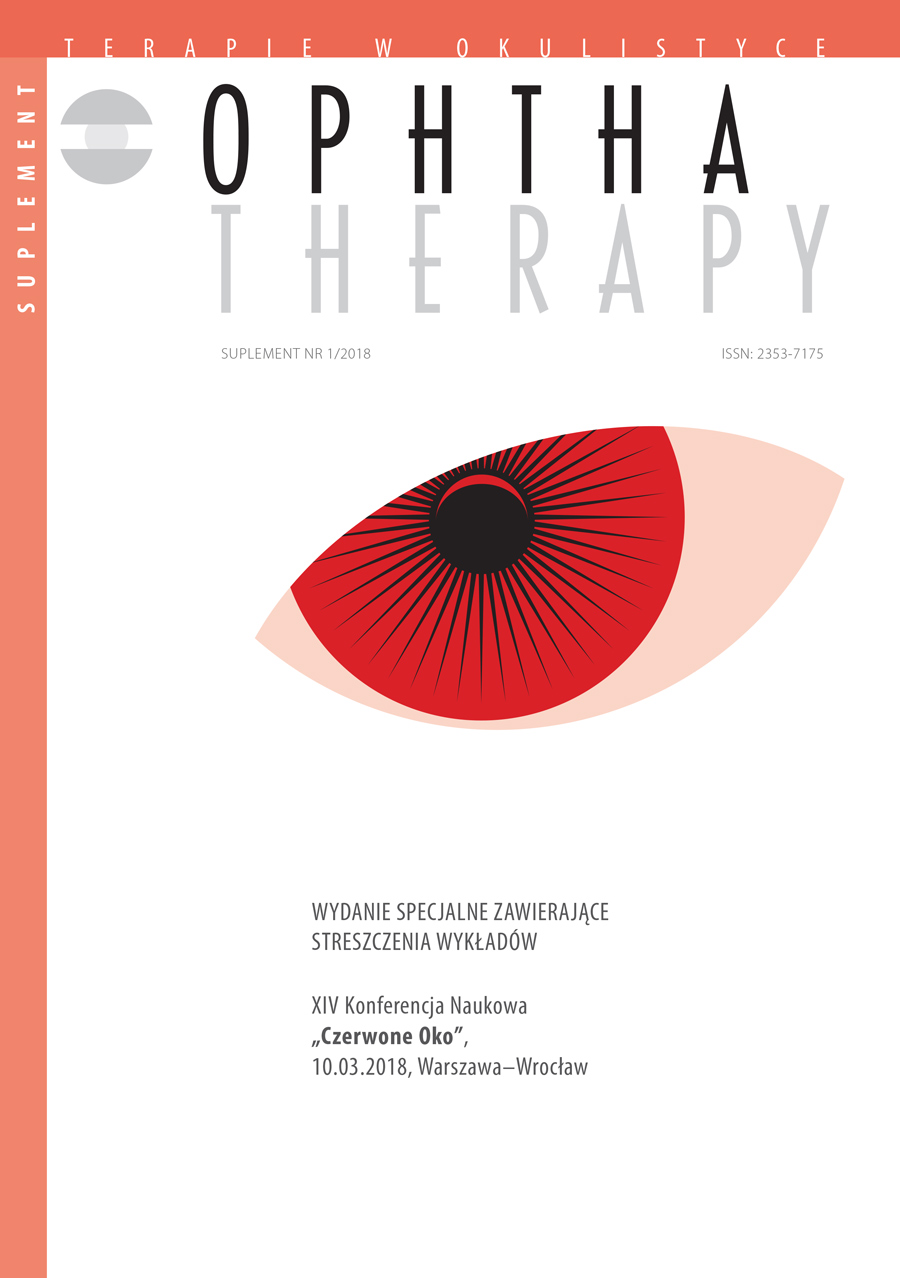Możliwości współczesnej kontaktologii
##plugins.themes.bootstrap3.article.main##
Abstrakt
Obserwowany w ostatnich latach dynamiczny rozwój kontaktologii to dopiero zapowiedź prawdziwego przełomu w korekcji optycznej wad wzroku. Projekty nowoczesnych soczewek kontaktowych daleko wykraczają poza podstawowe wskazania do ich aplikacji. Wśród wskazań terapeutycznych na uwagę zasługuje udział soczewek w ograniczeniu postępu krótkowzroczności oraz rehabilitacji osób słabowidzących. Obiecujące wydają się badania nad użyciem soczewek kontaktowych do pomiaru stężenia biomarkerów w filmie łzowym, co pozwoli na wczesną diagnostykę i monitorowanie chorób ogólnych. Prawdopodobnie już niedługo będziemy mogli aplikować soczewki jako nośnik leku z określoną, indywidualnie dopasowaną kinetyką uwalniania środka leczniczego. Gwałtowny rozwój elektroniki i miniaturyzacji powoduje, że era inteligentnych soczewek staje się coraz bardziej prawdopodobna i bliższa.
Pobrania
##plugins.themes.bootstrap3.article.details##

Utwór dostępny jest na licencji Creative Commons Uznanie autorstwa – Użycie niekomercyjne – Bez utworów zależnych 4.0 Międzynarodowe.
Copyright: © Medical Education sp. z o.o. License allowing third parties to copy and redistribute the material in any medium or format and to remix, transform, and build upon the material, provided the original work is properly cited and states its license.
Address reprint requests to: Medical Education, Marcin Kuźma (marcin.kuzma@mededu.pl)
Bibliografia
2. Jones L, Luensmann D. Protein deposition on contact lenses: The past, the present, and the future. Contact Lens & Anterior Eye. 2012; 35: 53-64.
3. Ng A, Heynen M, Luensmann D et al. Impact of tear film components on conformational state of lysozyme deposited on contact lenses. J Biomed Mater Res Part B. 2013; 101B: 1172-81.
4. Schornack MM. Scleral lenses: a literature review. Eye & Contact Lens. 2015; 41: 3-11.
5. Kepecs MR, Boro A, Haut S. A novel nonpharmacologic treatment for photosensitive epilepsy: a report of three patient tested with blue cross-polarized glasses. Epilepsia. 2004; 9: 1158-62.
6. Park WL, Sunness JS. Red contact lenses for alleviation of photophobia in patients with cone disorders. Am J Ophthalmol. 2004; 137: 774-5.
7. Taibbi G, Wang ZI, Dell’Osso LF. Infantile nystagmus syndrome: Broadening the high-foveation- quality field with contact lenses. Clin Ophthalmol. 2008; 2: 585-9.
8. Eslani M, Baradaran-Rafii A, Movahedan A, Djalilian AR. The ocular surface chemical burns. J Ophthalmol. 2014; 2014: 196827. https://doi.org/10.1155/2014/196827.
9. Wu PC, Huang HM, Yu HJ et al. Epidemiology of myopia. Asia Pac J Ophthalmol. 2016; 5: 386-93.
10. Gifford P, Li M, Lu H et al. Corneal versus ocular aberrations after overnight orthokeratology. Optom Vis Sci. 2013; 90: 439-47.
11. Zhu M, Feng H, Zhu J, Qu X. The impact of amplitude of accommodation on controlling the development of myopia in orthokeratology. Zhonghua Yan Ke Za Zhi. 2014; 50: 14-9.
12. Walline JJ, Jones LA, Sinnott LT. Corneal reshaping and myopia progression. Br J Ophthalmol. 2009; 93: 1181-5.
13. Charm J, Cho P. High myopia-partial reduction ortho-k: a 2-year randomized study. Optom Vis Sci. 2013; 90(6): 530-9. https://doi.org/10.1097/OPX.0b013e 318293657d.
14. Sankaridurg P, Holden B, Smith E 3rd et al. Decrease in rate of myopia progression with a contact lens designed to reduce relative peripheral hyperopia: one-year results. Invest Ophthalmol Vis Sci. 2011; 52: 9362-7.
15. Loertscher M. Multifocal orthokeratology associated with rapid shortening of vitreous chamber depth in eyes of myopic children. Contact Lens Ant Eye. 2013; 36(Suppl 2): e2.
16. Chehab K, Shedden AH, Cheng J. Lens incorporating myopia control optics and muscarinic agents. U.S. patent 20140036225 A1, February 6, 2014.
17. Stone JL, Robin AL, Novack GD et al. An objective evaluation of eyedrop instillation in patients with glaucoma. Arch Ophthalmol. 2009; 127: 732-6.
18. Bobba S, Chow S, Watson S et al. Clinical outcomes of xeno-free expansion and transplantation of autologous ocular surface epithelial stem cells via contact lens delivery: a prospective case series. Stem Cell Res Ther. 2015; 6: 23.
19. Foulds WS, Barathi VA, Luu CD. Progressive myopia or hyperopia can be induced in chicks and reversed by manipulation of the chromaticity of ambient light. Invest Ophthalmol Vis Sci. 2013; 54: 8004-12.
20. Vincent SJ. The use of contact lenses in low vision rehabilitation: optical and therapeutic applications. Clin Exp Optom. 2017; 100(5): 513-21.
21. Vincent SJ. The use of contact lens telescopic systems in low vision rehabilitation. Cont Lens Ant Eye. 2017; 40: 131-42.
22. Dunbar GE, Shen BY, Aref AA. The Sensimed Triggerfish contact lens sensor: efficacy, safety, and patient perspectives. Clin Ophthalmol. 2017; 11: 875-82.
23. Vitish-Sharma P, Acheson AG, Stead R. Can the Sensimed Triggerfish lens data be used as an accurate measure of intraocular pressure? Acta Ophthalmol. 2018; 96: 242-8.
24. Kim D, Kim D, Lee H et al. Body-attachable and stretchable multisensors integrated with wirelessly rechargeable energy storage devices. Adv Mater. 2016; 28: 748-56.
25. Park J, Kim J, Kim SY et al. Soft, smart contact lenses with integrations of wireless circuits, glucose sensors, and displays. Sci Adv. 2018; 4: eaap9841.26.

